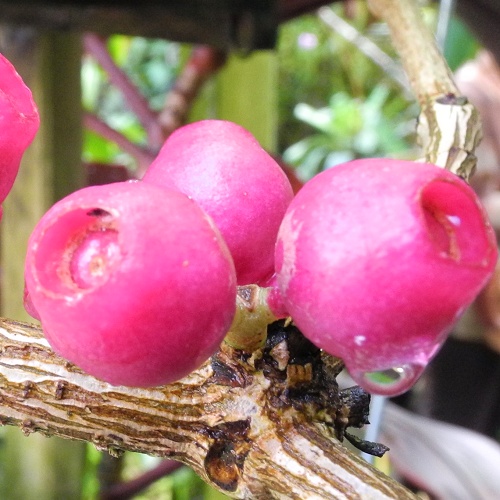Germinating the seeds
Getting started -- Your seed packet may contain small pieces of debris (dried fruit) mixed in with the seeds. You don't need to separate the seeds - simply sprinkle everything on the soil as described below. When to plant - Plant them when you receive them for best germination. Soil -- The soil should be well-draining and high in organic matter. A good mix to germinate
them in is 1 part sterilized potting soil and 1 part
perlite Pot size - Use small pots, or cups with drainage holes, about 1.5 to 3 inches tall (4-7 cm). Fill the pots with the soil mix and water it until it is evenly moist (but not soggy). Place a seed or 2 on top, and tap the pot gently to settle the seeds into the cracks of the soil.
Next add water until everything is evenly moist (but not soggy). Until the seeds sprout, it's important not to let the soil surface dry out. It may be best to enclose the pots in a plastic container or bag to maintain moisture. Just leave it open a crack to allow some fresh air in. You may need to drip a few drops of water on the surface one or more times a day to keep it moist. Aim to keep the seeds between 66 and 81° F (19-27°C). I have no information about how well they germinate outside that temperature range. I recommend placing a minimum/maximum thermometer near the pots, especially if using a heating mat. Place the containers in a bright spot out of direct sun. An LED or fluorescent lamp kept 4 inches (10 cm) away provides the right amount of light (See: "Growing indoors with LED lights"). They should begin sprouting within about 6 weeks, but occasionally may take up to 10 weeks to start. The seedlings are small when they sprout, and they grow slowly, so they require close monitoring the first few 2-3 months, to ensure they aren't neglected. Lighting -- After they sprout, continue giving them in a bright spot, with protection from afternoon sun. Watering: Continue keeping the soil surface moist. Once they are 6 weeks old, you may allow the soil surface to dry out between waterings, but aim to keep the rest of the soil evenly moist most of the time. Never let it dry out completely, but also avoid keeping it constantly soggy. If your water supply is very high in minerals (= "hard water"), you might need to use bottled water or rainwater. Feeding -- For the first 4 months, feed weekly with a small amount of dilute (1/8 strength) liquid fertilizer that contains micronutrients. Hydroponic fertilizer is ideal for seedlings, because it is easily absorbed and contains all essential nutrients. When they are 4 months old, you may switch to a granular fertilizer. Use an all-purpose fertilizer that contains micronutrients. Climate -- It will probably need to be grown indoors, except in Zones 10 or above. Ideal temperatures seem to be between 55 and 85 degrees F (13-29°C). I have no information how it will do outside that temperature range. Since it comes from forests, it enjoys filtered sunlight. Adult plants can handle some sun, but may need some shade from strong afternoon sun. Over about 50% humidity is best. If your plants seem to suffer from low humidity indoors, consider using an ultrasonic humidifier, sold at home improvement stores and some thrift shops. Repotting -- Once your seedlings are at least 1.5 inches tall (4 cm), you may repot them to larger containers. Repot gently to avoid damaging the root hairs. Repot into a porous mix, such as half potting soil and half fine-grade orchid bark (or perlite). For the first week or two after repotting, shade from sun and give no fertilizer. Insects to watch for -- Look for any insects that you find on your other houseplants. Try using insecticidal soap before using stronger remedies, since some may harm the plant. Happy growing! - Jeff Strange Wonderful Things
|
|||||||||


